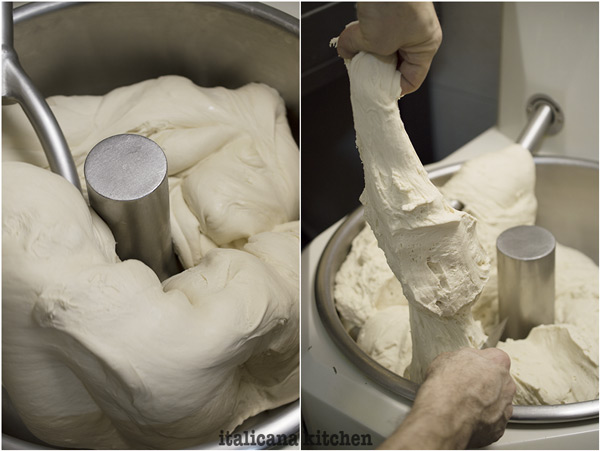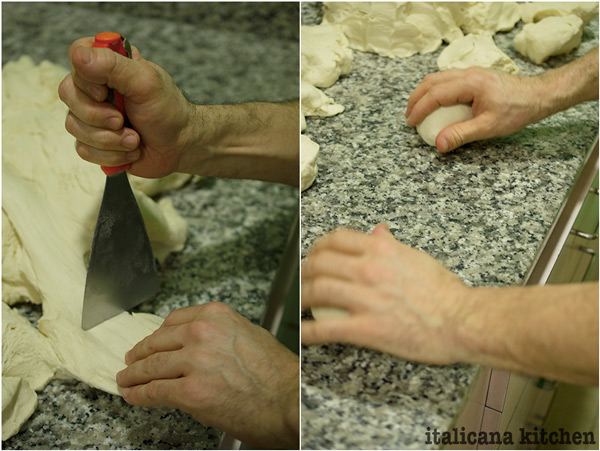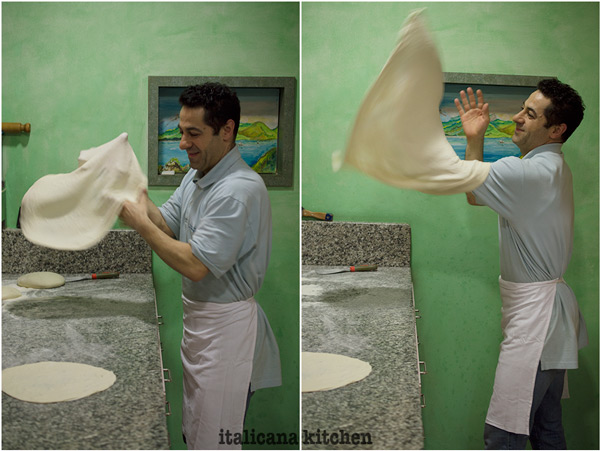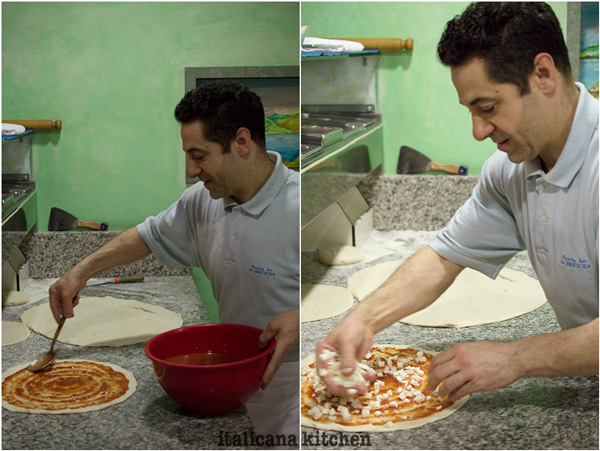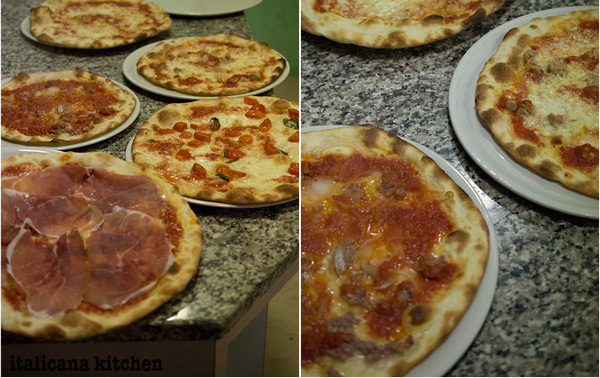Flour, baking powder, salt, olive oil and water are the base ingredients for making an Italian thin crust wood fired pizza. You would think then that all dough would be the same or that all pizzas would be equal in taste. So, not true. Each pizza chef, or pizzaiolo, as they say in Italian, has his own secret recipe, quality of ingredients and oven that make a big difference in outcome of this beloved dish. According to mine and Mr. Italicano’s taste buds, the pizzeria, The Briciola, in Correggio, Italy is among the best. Carmelo, the owner, was kind enough to let me come in and get a behind the scenes look on making authentic Italian pizzas.
A pizzaiolo’s work day is by no means easy. The hours are long and there is a lot of muscle involved. By 8:00a.m. Carmelo is already in the store pouring in huge sacks of flour and the other ingredients in an enormous professional mixer which twirls everything together until reaching a soft pillow of dough. He then stuffs the dough into large plastic containers and transfers them to the refrigerator to rest for roughly six hours.
Around 2 p.m. It’s time to get the arm muscles moving. Cutting a big chunk of dough from one of the containers he slaps it on a sparkling clean marble counter and begins to cut off smaller chunks of dough with a pizza spatula.
“How do you measure the size?” I ask Carmelo.
“I’ve been doing this for many years,” he replies, “by now it just comes naturally.” Without losing a beat he lays the spatula down and begins rolling the chunks into small balls against the counter, both hands moving in unison like an automated car waxing machine.
“This size is for a regular pizza,” he says working with such speed that the balls were already formed and he was reaching for the spatula again. “This is the size of a small pizza,” he said while chopping off a few smaller chunks, “and this for a large,” he added while cutting some more, only this time larger.
“The balls of dough will now be placed in the drawers to rise for 4-6 hours, like these,” he said opening two of the drawers that lined the front of the counter. The dough looked like babies cheeks that were soft and flawless and begging to be pinched.
“Now for rolling out the pizza,” Carmelo said throwing flour on the marble countertop like a carefree rich business man tossing his chips in the center of a poker table. He took one of the medium sized balls from the drawer and flung it on the counter, a puff of flour rose in the air. His hands began to press into the dough like a piano player playing a dramatic melody.
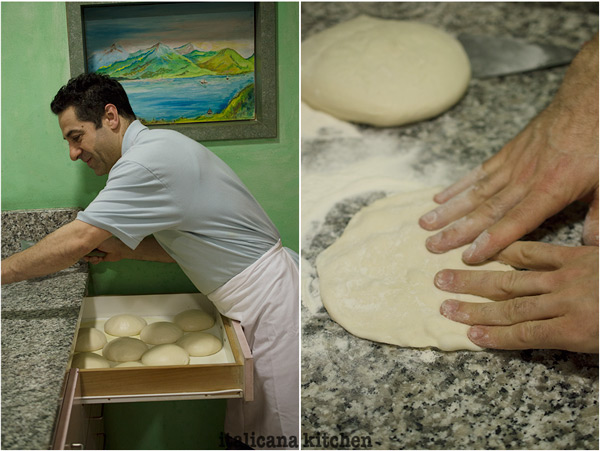 Now comes the fun part, the dough being flipped into the air, mesmerizing just like in the scene from a classic Italian film. In a blink of an eye, the dough that was flattened into a disc turns into a giant flying saucer. Carmelo makes it look so easy; however, I know if I were to try it, I would end up with a dough beret on my head.
Now comes the fun part, the dough being flipped into the air, mesmerizing just like in the scene from a classic Italian film. In a blink of an eye, the dough that was flattened into a disc turns into a giant flying saucer. Carmelo makes it look so easy; however, I know if I were to try it, I would end up with a dough beret on my head.
In the time that the dough rose, Carmelo had prepped the topping station. Bunches of fresh basil, sliced olives, salty capers and numerous other ingredients filled the containers. Carmelo grabbed a large bowl filled with a deep red tomato sauce and spooned it onto one of the flattened discs, using the back of the spoon to evenly distribute it out.
“I’ll make you a Pizza Margherita,” he said, reaching for some cubed mozzarella cheese and topping it with a few basil leaves. The Pizza Margherita is a prized pizza invented by Raffaele Esposito in the late 1800’s for the visit of King Umberto 1 and Queen Margherita of Savoy. The pizza represents the Italian flag which is green (basil), white (mozzarella) and red (tomato).
Carmelo carefully pulled the prepped pizza dough onto the pizza peel like a woman pulling on a pair of skinny jeans that are too small, an inch or two at a time until fully on. He then opened the oven and with a few quick jabs of the peel, the pizza was lying on the hot brick to bask away in the 572°F (300°C) heat.
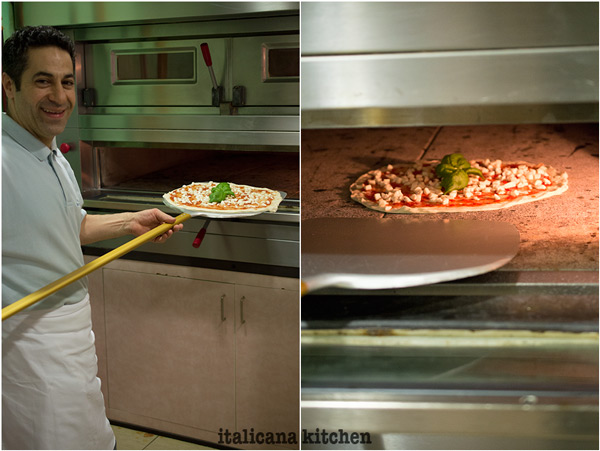 After 3-4 minutes, Carmelo was in front of the oven and with another 2 quick jabs the baked pizza was back on the peel then sitting on top of the countertop, perfectly cooked with a golden crust and glistening melted cheese.
After 3-4 minutes, Carmelo was in front of the oven and with another 2 quick jabs the baked pizza was back on the peel then sitting on top of the countertop, perfectly cooked with a golden crust and glistening melted cheese.
 Talk about some self-restraint, I wanted to devour the pizza immediately. I forced the thought to pass as I had work to do in order to capture this delicious edible treat. Carmelo’s daughter, Linda, was a great assistant and hand model. Look at the photo below closely. Do you see how it’s perfectly bent? If you go to some pizzerias you find some pizzas that are so thin and soggy with sauce that you can’t pick up a slice in your hand, others are so thick that you have trouble bending it; Carmelo’s pizzas, however, have just the right thickness and crunch to make you want to eat the entire thing. The best part about eating pizza in Italy, is that you typically do! Whereas in the states we usually order a pizza to share, in Italy each person typically orders their own.
Talk about some self-restraint, I wanted to devour the pizza immediately. I forced the thought to pass as I had work to do in order to capture this delicious edible treat. Carmelo’s daughter, Linda, was a great assistant and hand model. Look at the photo below closely. Do you see how it’s perfectly bent? If you go to some pizzerias you find some pizzas that are so thin and soggy with sauce that you can’t pick up a slice in your hand, others are so thick that you have trouble bending it; Carmelo’s pizzas, however, have just the right thickness and crunch to make you want to eat the entire thing. The best part about eating pizza in Italy, is that you typically do! Whereas in the states we usually order a pizza to share, in Italy each person typically orders their own.
 I stopped back in during the evening rush to capture the marble slab full of hot pizzas.
I stopped back in during the evening rush to capture the marble slab full of hot pizzas.
The pizzeria was alive with customers at tables and orders being taken over the phone for pick up. Observing Carmelo was like watching a pendulum in a clock, back and forth he went from the marble counter to the oven, switching out the pizza peel size in between and filling up to-go boxes with hot cheesy discs.
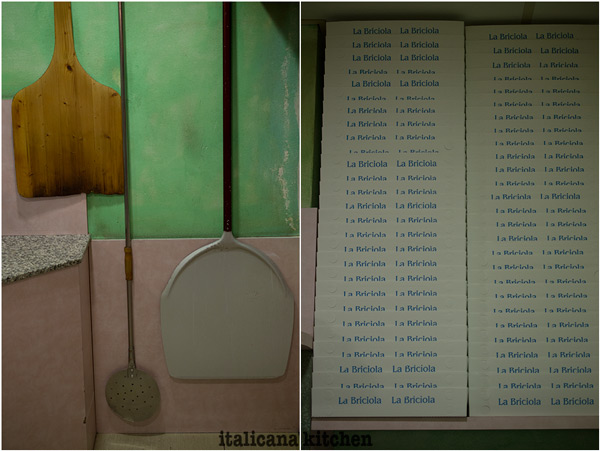 Carmelo slid another pizza in the oven as his employee Paola took two others out to the tables; customers waited in the lobby breathing in the aromatic air of freshly baked bread. It was just another night for Carmelo, but for me it was a taste of Italy and a glimpse of tradition that transformed an ordinary evening into a memorable moment.
Carmelo slid another pizza in the oven as his employee Paola took two others out to the tables; customers waited in the lobby breathing in the aromatic air of freshly baked bread. It was just another night for Carmelo, but for me it was a taste of Italy and a glimpse of tradition that transformed an ordinary evening into a memorable moment.


